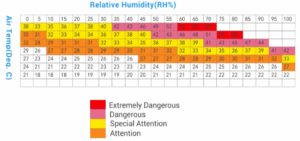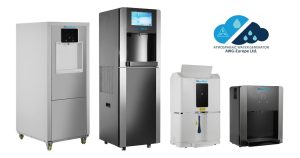We often hear about the importance of hydration, but what about atmospheric humidity?
Humidity is the amount of water vapor in the air, which can typically be described by two parameters: absolute humidity and relative humidity. The dew point is an absolute value that indicates how humid and muggy the environment is.
What is the ideal temperature and humidity for the human body?
In the age of central heating and air conditioning, regulating temperature is second nature to everyone. Unfortunately, however, few people control humidity, and typically only when there is already a problem.
The ideal temperature is 23-26℃, while the ideal relative humidity is 40-60% RH.
Concepts related to thermal comfort
Temperature (true) is the measured value of the temperature of a given space. Temperature is the most commonly used word in weather forecasting.
Apparent temperature refers to how people perceive the air temperature. It is influenced by air temperature, relative humidity, and wind speed.
For example, if the air temperature is 32°C and the relative humidity is 60%, we may feel a temperature of 38°C, or if the air temperature is 29°C and the relative humidity is 90%, we may feel a temperature of 39°C, which is 10 degrees higher than the actual temperature.
Absolute humidity is the actual amount of water vapor in the air. The greater the amount of water vapor, the higher the absolute humidity.
Relative humidity shows the amount of water vapor in the air as a percentage, compared to the maximum amount of water vapor that can be stored in the air at a given temperature. Relative humidity is 100% when the air is completely saturated with water vapor.
Warm air can hold more water vapor or moisture than cold air. Therefore, at the same absolute humidity, cold air has a higher relative humidity and warm air has a lower relative humidity.
The dew point is the temperature at which water vapor turns into liquid water droplets. This process is called condensation. The dew point is always the same or lower than the actual outside temperature.
Can too high or too low humidity be harmful?
Yes, too high or too low humidity can definitely be harmful, not only to your health, but also to your home and belongings.
Health effects of humidity:

High humidity above 60% RH
- Promotes the growth of mold and dust mites, which can cause allergies and respiratory problems.
- Makes sweating more difficult, so the body has a harder time cooling itself, which can lead to fatigue.
- It can promote the spread of bacteria and viruses.
- Relative humidity above 70% can cause malaise, loss of appetite, fatigue, dizziness, and other symptoms.
- Damp and moldy rooms increase the risk of asthma, rheumatism, and eczema.
Low humidity below 30% RH
- Dries out the mucous membranes, which can cause a sore throat, coughing, and nasal congestion.
- Increases static electricity, which can be unpleasant.
- Can dry out the skin, lips, and eyes, causing itching or irritation.
- Dust and bacteria easily adhere to human mucous membranes and can easily trigger respiratory diseases such as asthma.
Effects on the home environment
High humidity
- Can cause mold growth on walls, furniture, and textiles.
- Can cause wood to swell, leading to deformation.
- Stored food becomes moldy.
Low humidity
- Can cause cracks in wooden furniture and parquet flooring.
- Dries out painted surfaces, which can damage the home over time.
- Houseplants dry out easily
What to watch out for in hot weather?
During a heatwave, high humidity can have a number of harmful effects on the human body, contributing to feelings of low energy and lethargy, and can also cause hyperthermia (hyperthermia = overheating, as the body is unable to release heat efficiently). In addition to proper hydration, it is worth heeding the warnings and advice of NBC NEWS in It’s topic “Not Just the Heat, It Really Is the Humidity: Know the Risks”.
What can we do to ensure healthy air?
If you have a humidity meter, it is worth monitoring the level, especially during the heating season or summer heat waves. Don’t wait for your body to signal that the air is too dry or too humid!
What methods can you use to achieve the ideal humidity level of 40-60%?
In case of excessive humidity
- Dehumidifier: the most effective tool for removing excess moisture.
- Air conditioner: modern air conditioners have this function
- Ventilation: several times a day, especially after cooking and showering. Cross ventilation is also important!
- Reduce plants: some plants increase the humidity of the air.
- Kitchen and bathroom extractor fans: help to remove moist air.
- Moisture-absorbing materials: such as silica gel or calcium chloride, which can be placed in smaller rooms.
In case of too low humidity
- Humidifier: emits cold or warm mist, helps alleviate dry air.
- Placing a bowl of water on the radiator: a simple but effective method.
- Houseplants: increase the humidity of the air through evaporation (e.g. palm trees, ficus).
- Hanging wet towels: placing a wet towel on a radiator overnight can work wonders.
- Cooking and showering with the door open: you can use the steam to humidify the air.
A good tip for making the best use of atmospheric moisture
Most of humanity lives along waterfronts, and these areas typically have high humidity. Where temperatures are warm, such as in the Mediterranean region, it is possible to use humidity as drinking water source with the help of Atmospheric Water Generator (AWG) machines. Not only will you have clean and healthy drinking water, but your home will also have healthier, cleaner, and pleasantly cool air. When used in conjunction with solar panels, this technology provides sustainable and environmentally friendly drinking water that is independent of service providers and free of PET bottles.
If you would like to know more about this, visit AWG-Europe and the WizzWell online store!


Nice post. I learn something totally new and challenging on websites
I appreciate you sharing this blog post. Thanks Again. Cool.
Thank you for sharing such a well-structured and easy-to-digest post. It’s not always easy to find content that strikes the right balance between informative and engaging, but this piece really delivered. I appreciated how each section built on the last without overwhelming the reader. Even though I’ve come across similar topics before, the way you presented the information here made it more approachable. I’ll definitely be returning to this as a reference point. It’s the kind of post that’s genuinely helpful no matter your level of experience with the subject. Looking forward to reading more of your work—keep it up! profis-vor-ort.de
This is the least that needs to be done. Thank you for your comment!
我来看看是咋么回事
Your blog is a breath of fresh air in the often stagnant world of online content. Your thoughtful analysis and insightful commentary never fail to leave a lasting impression. Thank you for sharing your wisdom with us.